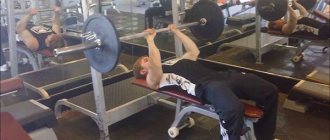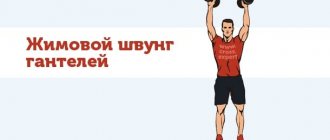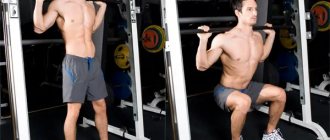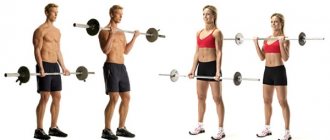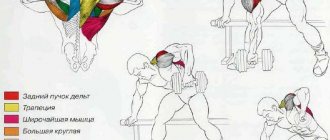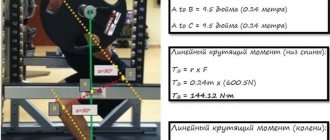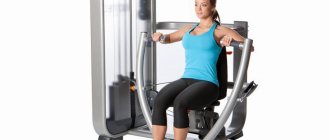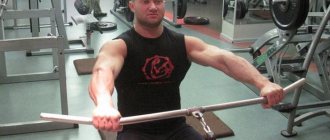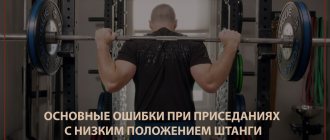Muscles involved
A pullover is an exercise that “pumps up” 2 large muscle groups at once:
- Breasts
- Latissimus dorsi muscles.
In addition, a long triceps bundle is involved in the pullover. The distribution of load between these three muscles varies depending on the range of motion and the angle of the bench.
Active muscles when performing a pullover with dumbbells
The pecs and triceps in the starting position are extremely stretched. They receive 80% of the load during the phase of raising their arms from behind the head and straightening them. Turning to anatomy, we understand that it is impossible to perform such a movement without the participation of these two muscles. It follows that a pullover can be a good “finishing” exercise on chest and arm day.
This isolating exercise is also suitable for “targeted” work of the back muscles: after the hands pass through the vertical, the pectoral and triceps lose “power” and transfer “control” to the lats. Of course, the range for their full involvement in the work is too small, so to properly work out the back muscles, use an inclined bench (position below the horizontal).
Nuances of performing the exercise
It is worth paying attention to the following nuances:
The movement should be carried out by stretching the pectoral muscles and ribs.
You should not raise your pelvis and lower the projectile like a rocker arm, the fulcrum of which is your shoulders.
The main purpose of the exercise is to stretch, and if the dumbbell is lowered due to body movement, the exercise loses its effectiveness.
When performing, a large load is placed on the athlete’s shoulder joints.
In addition, a large amplitude of arm movement increases the risk of injury. Therefore, you should not lower the projectile all the way to the floor, turning the joints inside out.
If your arms are in line with your body, this will be enough for progress.
The exercise is somewhat different from the standard ones. When performing it, microtrauma of muscle fibers occurs, but not in the same way as when performing basic approaches.
It involves a mechanism of tension with simultaneous stretching. This allows you to increase the volume of short areas, due to which the pectoral muscles gain additional size and strength.
You should not take heavy weights for work. It comes with danger and effectiveness.
The fact is that an additional 5-10 kilograms in your hands will little speed up progress, but it can cause poor technique.
On the Internet, even professional athletes in the photo of doing pullovers with dumbbells use medium weights.
It is best to include this exercise after heavy squats or barbell presses.
In the first case, this helps to increase breast volume, since the lungs actively work during the exercise. In the second, the fibers are stretched after strong contractions, which helps to increase tissue elasticity and increase mass.
Before doing a pullover with dumbbells, you need to warm up. Cold muscles stretch less easily, and joints may not be able to withstand much stress.
In addition, you need to monitor the movement of the buttocks, which should remain in one position. Otherwise, excessive stress is placed on the back vertebrae and cartilage discs.
Pullover with barbell
Equipment: horizontal or inclined bench, barbell with a straight bar.
Approaches: 2-3
Repetitions: 10-15
Technique:
- Press your entire body tightly against the bench. Position your head so that it is on the edge of the bench, but does not hang down. Spread your legs wider (approximately as if you were doing a bench press) and press them firmly into the floor. Ask a friend to give you a barbell with well-fixed plates.
- Take the bar with an overhand grip (the distance between the hands is 25-30 cm) and bring it above you, almost completely straightening your arms. Exhale. Ready?
- Bend your elbows slightly and begin to smoothly lower the barbell back and down, bringing it behind your head. Continue until you feel your pecs and lats stretch, but don't let your shoulder joints become painful. The trajectory of the barbell movement is a semicircle.
- Hold your hands at the point of highest tension for 1.5-2 seconds. Next, with a powerful but smooth movement, return the projectile to its original position, moving it along the same trajectory. Don't forget that your arms should always be bent at the elbows (we take care of the joints).
Incline Barbell Pullover: Active Muscles
Tips for implementation:
- When lowering the barbell, take a deep breath; when lifting, forcefully exhale.
- Remember that your goal is maximum stretching of the sternum muscles
- Maintain an angle of your elbow joints of about 150 degrees
- When you master the technique of performing a pullover with a straight bar, switch to a curved one - it’s safer for your joints
- If you feel discomfort in the spine and abdominal cavity, place your feet on a bench
- The main thing is to maintain a stable position of your torso, pressing tightly against the bench
Common mistakes
The most common mistakes made when performing different pullover variations:
- jerking movements performed during the exercise reduce its effectiveness and cause injuries;
- improper breathing, holding it can cause dizziness;
- an increase in the amplitude of movement when the barbell or other projectile is moved excessively behind the head leads to an increase in the level of injury;
- high speed of movements reduces the quality of muscle development;
- lifting the hips during the exercise leads to a shift of the load from the chest area, and therefore reduces the effectiveness of the exercise;
- emphasis on the floor with arching of the back during the “breathing pullover” can lead to a lower back injury;
- alignment of the arms at the elbows during the exercise can provoke a loss of control over the dumbbells and, as a result, shoulder injuries;
- Rocking and sudden tearing movements when performing a pullover with a machine or barbell creates stress for the shoulder joint, or rather its cartilage tissue. A sharp return to the starting position, when the bar of the simulator flies up, in combination with arms straightened at the elbows, leads to the appearance of inflammatory processes;
- using heavy weight implements is a typical mistake for beginners, leading to overload of the shoulders. In a pullover, weight is not the main thing, so at the initial stage of training, a light barbell weighing about 15 kg or a dumbbell of 10 kg will be enough. For beginners who are unsure of their abilities, even when mastering the exercise, it is recommended to perform it with an empty bar to ensure the safety of the shoulder girdle and abs.
One of the typical mistakes that beginners also make is combining pullovers with other exercises to work the shoulder girdle. The pullover is designed to “finish off” the pectoral muscle mass, but not the shoulder muscles. The shoulder joints may not be able to cope with the load received when combining pullovers with other shoulder girdle exercises.
When performing a pullover with dumbbells or a barbell, you should pay special attention to the second part of the exercise, since as you raise your arms, the load on the muscles being worked decreases.
Representing a complex exercise, the pullover involves the muscles of the front of the body, shoulder girdle, arms and abdominals. It is optimally suited for “finishing off” working muscles at the final stage of complex training for both beginners and experienced athletes. To avoid painful injuries during training exercises, beginners should be careful when mastering the pullover with a light weight and avoid sudden movements.
Pullover with dumbbell
Equipment: horizontal or inclined bench, dumbbell with a handle convenient for working with two hands.
Approaches: 2-3
Repetitions: 10-15
Technique:
Pullover with a dumbbell: technique
- We lie down on the bench in the same way as when doing a pullover with a barbell. We ask your partner to hand you a dumbbell.
- We grasp the dumbbell by the end with both palms so that they are directed towards the ceiling. We raise the projectile above ourselves, gradually straightening our arms. Let's exhale.
- We begin to lower the dumbbell behind our head, intensely drawing in air through our chest. Move the apparatus in a semicircle until you feel that your pectoral and back muscles are well stretched.
- At the bottom point, hold your breath for 1.5-2 seconds and smoothly return the dumbbell to its original position, maintaining tension in your elbows and exhaling powerfully.
Tips for implementation:
- Don't bend your elbows too much—you're doing a pullover, not a French press.
- Proper breathing in this exercise is your main assistant in expanding the chest
- If you are uncomfortable doing pullovers with a dumbbell, you can replace it with a barbell plate of the same weight
- There is another variation of this exercise: you sit on the bench not along, but across (as in the photo above), leaning on it with the middle part of your back; in the first phase of the movement, lower your pelvis, and in the second, lift it
Execution technique
Classic pullovers with an accent on the back
To perform this option we will need a bench press and a dumbbell. Before we get started, we need to disassemble one small part. We are talking about how we will lie on the bench lengthwise or crosswise. In order to decide on this issue, you need to understand where the center of gravity is directed.
If we lie lengthwise on a bench, we will have 3 points of support: head, shoulders and pelvis. But as soon as we lower the projectile behind the head, the entire load from the pelvis will go to the shoulders and head. This will create a crushing load on the cervical vertebrae and ultimately lead to injury. I think many will agree that we are not happy with this prospect.
By placing ourselves across the bench, we remove our neck from the impact. Since we will have other support points: the shoulder girdle and feet. And the pelvis will have free movement both up and down. Therefore, by choosing a transverse position on the bench, we can make the exercise less traumatic.
I think we've decided on this. Now let's look at what the execution technique is.
Initial position:
- Place the bench press in a horizontal position. We rest against its side edge with the area just below the shoulder blades.
- We take the dumbbell in our hands. We can do this with the help of a partner or on our own if the weight is not heavy.
- As for the grip. The dumbbell in this exercise is an extremely dangerous weight. Before you take it, check that the pancakes are securely fastened. If they are loose, choose a different dumbbell. In the classic version, I recommend the brothers under the bottom of the top pancake. But it’s best to grab the bar with one hand and squeeze the palm of the hand holding the dumbbell with the other.
- Raise the dumbbell up above chest level. We bend our arms slightly at the elbow joint. When performing a pullover with an emphasis on the back, we can bend our arms up to an angle of 90°. Since our task is to move the elbows back, and not the entire arm. This will also relieve the triceps.
- Legs are bent. Feet are on the floor. The pelvis can be lowered down or raised up.
Performance:
- As you inhale, we begin to move the dumbbell behind your head. The main thing is to do this through the work of the shoulder joints, and not by bending the arms. Our movement should resemble raising your arm up, only in a lying position.
- While abducting the dumbbell behind the head, we can slightly lift the pelvis up. This will allow you to pull your elbows back further.
- As you inhale, by contracting the latissimus muscles, return the dumbbell to its original position.
The main thing when performing pullovers is to completely control the weight. Any sudden or jerky movement can injure the shoulder joint. At the lowest point we take a short pause in order to feel the maximum stretch of the back muscles.
Pullovers with an emphasis on the chest
I already wrote earlier that in the sports world there is an opinion about enlarging the chest with the help of pullovers. Whether this is true or not can only be found out by trying it yourself. I can only say one detail. The pecs will visually become larger if you perform this exercise frequently. But this effect is not the result of chest expansion, but the fact of posture straightening. You can check the houses yourself near the mirror. Stand in front of him. Straighten your shoulders, move your shoulder blades back. And if you already had well-developed pectoral muscles, then you should notice positive changes. In addition, we can actually use pullovers to target the pectoral muscles. To do this, it is enough to slightly reduce the amplitude of movement. And also, focus a little on the work of the breasts themselves. To perform this option, we will lie across the bench. You can also lie along the bench. But be aware of the risk of injuring your neck.
Initial position:
- Lie across a bench, similar to the one described above.
- Take the dumbbell in your hands and lift it above your chest. Bend your elbows slightly.
- The feet rest firmly on the floor. The pelvis is slightly lowered. The legs are bent at the knee joint.
- The shoulder blades are brought together.
Performance:
- As you inhale, we begin to lower the dumbbell behind your head, working in the shoulder joints.
- As soon as the dumbbell reaches head level, you should stop. Further lowering the weight will engage the latissimus muscles, and we don’t want that.
- As you exhale, we begin to lift the dumbbell upward. At the same time, we must mentally squeeze our hands together. Of course, we won’t be able to do the movement itself, since it won’t allow us to do the dumbbell bar. But thanks to such a simple manipulation, we can forcibly tense the pectoral muscles.
- At the top point, take a short break. This will allow the chest to work a little statically (maximum tension).
It is worth considering that the weight when performing this option will be significantly less. Therefore, you should not take a huge dumbbell. This exercise is not recommended for beginners. Because it will not bring them the desired result. It is better to give preference to heavier basic exercises. Such as: BAR PRESS or DUMBLEL PRESS lying down. Professional athletes use it as a finishing exercise at the end of training.
Pullover in a block trainer
Equipment: upper block for standing.
Number of approaches: 2-3
Number of repetitions: 12-15
A pullover on a block is an excellent tool for giving shape and definition to the latissimus dorsi and lower chest muscles.
Muscles used when performing a pullover on a pulley machine
Before performing a pullover, adjust the simulator to your parameters (the handle of the block should be at head level).
Technique:
- Take the starting position: turn to face the block, take the handle with a straight grip. Step back a little, bend your legs slightly at the knees, tilt your body forward, keeping your back straight. Maintain a slight bend in your elbows. The handle of the block should be 20-30 cm in front of your head.
- Take in more air into your lungs and with a powerful movement, pull the handle down, remembering to bend your arms at the elbow joint. The trajectory is an arc of large radius.
- Lower your arms until they reach your upper thighs. Hold them in this position, feeling the tension in your pecs and lats.
- Exhale completely and smoothly return your hands to the starting position.
Tips for implementation:
- Pullover on a block does not require the use of large weights; in this case, it is the quality of muscle development that is important
- We remind you once again: keep a moderate bend in your elbows
- keep your body motionless so that “extra” muscles are not involved in the work
- breathe deeply - this is important to keep the spine in the correct position
Flaws
This exercise does not belong to the basic class, so you should not put it at the center of your training program. Don't forget that most muscle mass is built by doing the bench press, deadlift and squat. And a pullover is a good isolating exercise that will give your pectoral and back muscles a beautiful definition and make your skeleton wider.
Does exercise harm your shoulders?
If performed incorrectly, the pullover puts excessive pressure on the cartilage surrounding the shoulder joint. If they are damaged, the athlete will have to postpone training for 3-6 months.
If you listen to the following tips, your shoulders will be in perfect order:
- warm up your shoulder joints thoroughly before doing a pullover
- maintain a moderate range of motion, do not lower the projectile too far behind your head
- start with small weights
Useful tips
Previously, we gave tips on making specific types of pullovers, now it remains to summarize them:
- Be sure to maintain a slight bend in the elbow joint
- Do pullovers with an EZ barbell more often. This will relieve some of the dangerous stress on your elbows and wrists.
- Lower the exercise until you feel a stretch in your muscles, not pain in your shoulders.
- Don't be shy about asking your partner for help if you need insurance.
- Don't use cheating
To summarize, we can say:
Pullover is an extremely useful exercise, for which you do not have to purchase expensive equipment that takes up a lot of space. The pullover is suitable for both beginners dreaming of a strong chest, and experienced athletes looking for an effective “finishing” exercise for the chest and back muscles.
The main thing is to increase the weight of the projectile gradually and do not forget to follow a safe technique for performing this exercise to avoid injuries to the shoulder and elbow joints. A pullover is another weighty “brick” in building a powerful and beautiful body.
